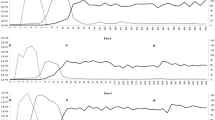Summary
A naturally acquired mouse strain of LCM virus maintained by congenital transmission was used to study the factors determining the birth of tolerantly infected litters by experimentally infected SPF mice. Tissues of individual SPF mice were tested for infectivity at intervals after the intramuscular inoculation of 1000 ID50 at various stages of gestation. Infectivity in the inoculated muscle was at its peak 4 to 7 days p.i. and then declined rapidly. The uterus and placentae became secondary sites of virus multiplication from the 5th day p.i. and were highly infective from about the 8th day. It was not until then that virus was regularly detected in the embryos at a titre of ⪖6.5 ID50/0.06 g which persisted after birth.
These results suggested an explanation for the pattern of incidence of tolerantly infected litters born to SPF mice exposed to virus during the 2 weeks before and after mating. Litters from mice infected earlier than 9 days before mating were not infective, but from this time up to 11 days after mating 56 of 149 litters from inoculated mice were infective. The incidence of infection over this period correlated with the duration of co-existence of the embryos with the peak infectivities detected at sites of virus multiplication, and in mice inoculated 0 to 8 days after mating 44 out of 58 litters contained infective mice. In 50 mice inoculated 12 to 14 days after mating, however, infection failed to reach the embryos before birth and post-natal transmission was not detected.
These findings indicate the best procedure for the experimental production of tolerantly infected mice by pre-natal infection.
Similar content being viewed by others
References
Haas, V. H.: Studies on the natural history of the virus of lymphocytic choriomeningitis in mice. Publ. Hlth Rep. (Wash.)56, 285–292 (1941).
Hoyland, F., E. H. Knight, andH. H. Skinner: Eradication of lymphocytic choriomeningitis (LCM) virus—a human pathogen—from a mouse breeding colony. J. Inst. Anim. Techns.23, 6–18 (1972).
Mims, C. A.: Effect on the fetus of maternal infection with lymphocytic choriomeningitis (LCM) virus. J. infect. Dis.120, 582–597 (1969).
Skinner, H. H., andE. H. Knight: Studies on murine lymphocytic choriomeningitis virus within a partially infected colony. Lab. Anim.3, 175–184 (1969).
Skinner, H. H., andE. H. Knight: Monitoring mouse stocks for lymphocytic choriomeningitis virus—a human pathogen. Lab. Anim.5, 73–87 (1971).
Skinner, H. H., andE. H. Knight: Natural routes for post-natal transmission of murine lymphocytic choriomeningitis. Lab. Anim.7, 171–184 (1973).
Traub, E.: Über die natürliche Übertragungsweise des Virus der lymphocytären Choriomeningitis (LCM) bei Mäusen und ihre Parallelen zum Übertragungsmodus gewisser muriner Krebsviren. Zbl. Bakt. I. Abt., Orig.177, 453–471 (1960).
Author information
Authors and Affiliations
Rights and permissions
About this article
Cite this article
Skinner, H.H., Knight, E.H. Factors influencing pre-natal infection of mice with lymphocytic choriomeningitis virus. Archiv f Virusforschung 46, 1–10 (1974). https://doi.org/10.1007/BF01240199
Received:
Issue Date:
DOI: https://doi.org/10.1007/BF01240199



